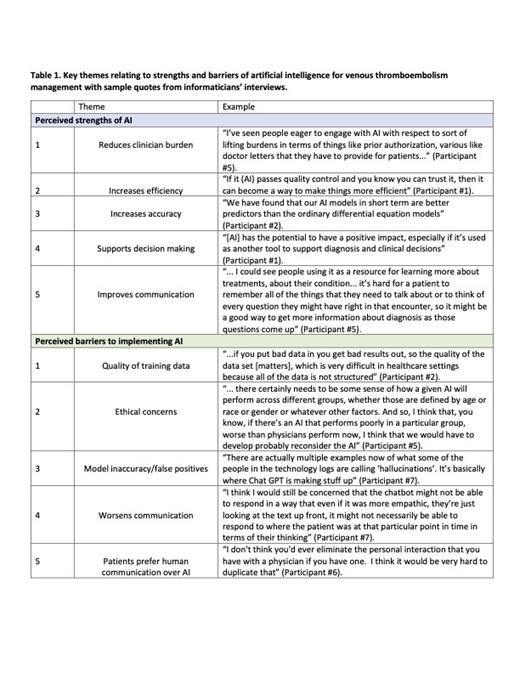Background:
Venous thromboembolism (VTE) is a significant cause of preventable death among hospitalized patients. Artificial intelligence (AI) and its sub-branch machine learning (ML) may be useful in standardizing and improving VTE management in hospitalized patients. To learn attitudes towards using AI for VTE, we previously conducted a national survey of 100 clinical informaticians recruited through professional organizations and a publicly available database listing recipients of National Institutes of Health informatics grant awardees (Lam et al, RPTH, 2023). For the current study, we interviewed a subset of these informaticians to explore their perspectives in depth on using AI in clinical decision making and VTE management.
Methods:
Survey participants interested in participating in interviews were asked to submit their email addresses. We then recruited these participants and asked them to recommend other informaticians who may be interested. We conducted 30-60 minute interviews via videoconference which were recorded and transcribed. Two coders separately reviewed the interviews using thematic analyses to develop a codebook. Codes were identified inductively and agreed upon by consensus. Once a codebook was agreed upon, it was used to code all interviews in duplicate.
Results:
Of 32 informaticians who were contacted, 11 agreed to be interviewed. The final participant group included 4 clinicians, 6 data scientists, and 1 biomedical/computational biologist. The major themes that emerged were that AI is a powerful tool to reduce clinician burden and AI is well suited to preventing and managing VTE, but bias in the creation of AI tools must be minimized. Since machine learning models increase accuracy and efficiency in clinical practice, they can serve as decision support and management tools and help to improve communication thereby reducing clinician burden. (Table 1)
Other than the ethical concerns regarding bias, subpar quality of training data and model inaccuracy were identified as potential challenges. ML tools need to be validated as safe and effective for their specific role. In addition, one theme highlighted that clinicians fear being replaced by AI, while another noted that most patients would prefer interacting with humans about their medical care over AI. There were multiple suggestions for implementation of AI. Participants noted that AI could be integrated into the EMR and that ML tools should be further investigated with input from domain experts (data scientists, computational biologists and clinicians). Finally, interviewees recognized that VTE management was an area of medicine in which AI could be used successfully given that it is a clearly defined problem that lends itself to an algorithmic solution which can incorporate the current guidelines into a tool within the EMR system.
Conclusion:
Informaticians see AI as a promising tool to support clinical decision making about VTE prophylaxis because not only does it increase accuracy and efficiency, but it is also a clearly defined area of clinical management where guidelines can be effectively incorporated into the EMR system via machine learning. Challenges identified to implementing AI/ML will have to be addressed in order to create an ethical and accurate model which reduces the burden on healthcare providers in the clinical setting.
Disclosures
Rosovsky:Pulmonary Embolism Response Team: Membership on an entity's Board of Directors or advisory committees, Other: President-Elect; BMS: Consultancy; Dova: Consultancy; Janssen: Consultancy, Other: Research funding is to my institution, Research Funding; Abbott: Consultancy; Penumbra: Consultancy, Other: National Lead Investigator for STORM PE; Inari: Consultancy. Zwicker:CSL Behring: Consultancy; Pfizer/BMS, Portola, Daiichi: Honoraria; Sanofi, CSL, Parexel: Consultancy; calyx: Consultancy; Incyte Corporation, Quercegen: Research Funding; Janssen: Consultancy; Sanofi: Consultancy.


This feature is available to Subscribers Only
Sign In or Create an Account Close Modal